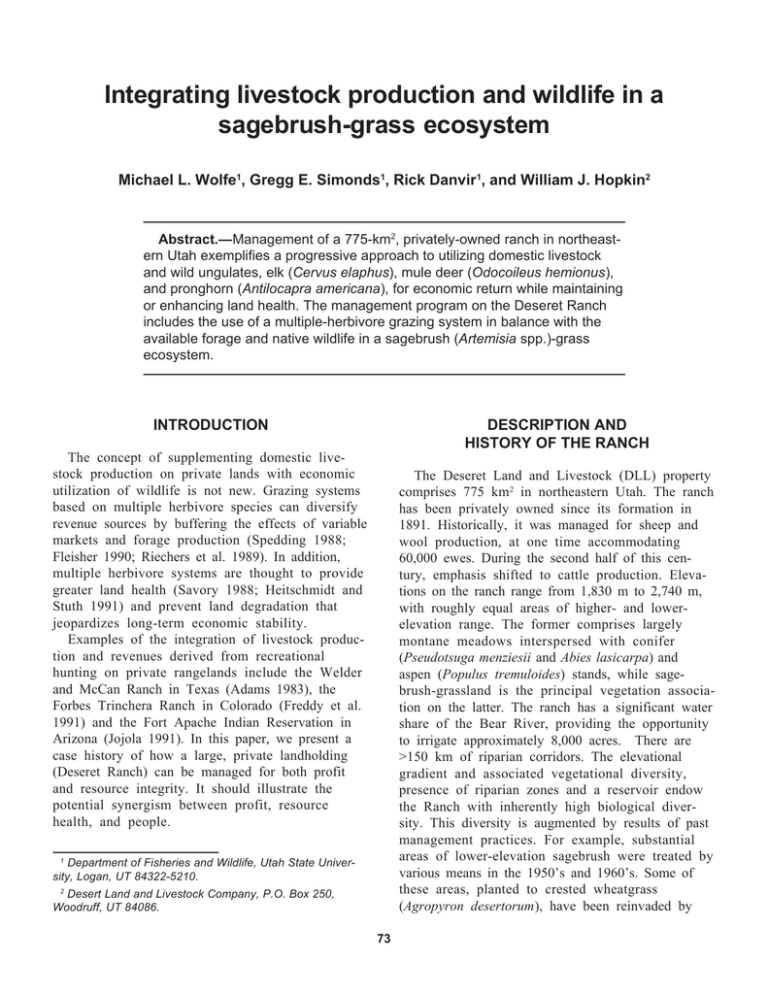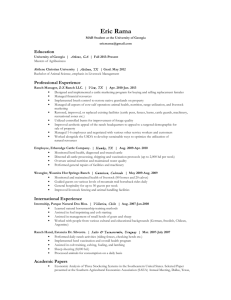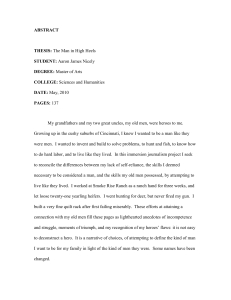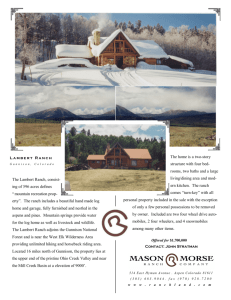Integrating livestock production and wildlife in a sagebrush-grass ecosystem Michael L. Wolfe
advertisement

Integrating livestock production and wildlife in a sagebrush-grass ecosystem Michael L. Wolfe1, Gregg E. Simonds1, Rick Danvir1, and William J. Hopkin2 Abstract.—Management of a 775-km2, privately-owned ranch in northeastern Utah exemplifies a progressive approach to utilizing domestic livestock and wild ungulates, elk (Cervus elaphus), mule deer (Odocoileus hemionus), and pronghorn (Antilocapra americana), for economic return while maintaining or enhancing land health. The management program on the Deseret Ranch includes the use of a multiple-herbivore grazing system in balance with the available forage and native wildlife in a sagebrush (Artemisia spp.)-grass ecosystem. INTRODUCTION DESCRIPTION AND HISTORY OF THE RANCH The concept of supplementing domestic livestock production on private lands with economic utilization of wildlife is not new. Grazing systems based on multiple herbivore species can diversify revenue sources by buffering the effects of variable markets and forage production (Spedding 1988; Fleisher 1990; Riechers et al. 1989). In addition, multiple herbivore systems are thought to provide greater land health (Savory 1988; Heitschmidt and Stuth 1991) and prevent land degradation that jeopardizes long-term economic stability. Examples of the integration of livestock production and revenues derived from recreational hunting on private rangelands include the Welder and McCan Ranch in Texas (Adams 1983), the Forbes Trinchera Ranch in Colorado (Freddy et al. 1991) and the Fort Apache Indian Reservation in Arizona (Jojola 1991). In this paper, we present a case history of how a large, private landholding (Deseret Ranch) can be managed for both profit and resource integrity. It should illustrate the potential synergism between profit, resource health, and people. The Deseret Land and Livestock (DLL) property comprises 775 km2 in northeastern Utah. The ranch has been privately owned since its formation in 1891. Historically, it was managed for sheep and wool production, at one time accommodating 60,000 ewes. During the second half of this century, emphasis shifted to cattle production. Elevations on the ranch range from 1,830 m to 2,740 m, with roughly equal areas of higher- and lowerelevation range. The former comprises largely montane meadows interspersed with conifer (Pseudotsuga menziesii and Abies lasicarpa) and aspen (Populus tremuloides) stands, while sagebrush-grassland is the principal vegetation association on the latter. The ranch has a significant water share of the Bear River, providing the opportunity to irrigate approximately 8,000 acres. There are >150 km of riparian corridors. The elevational gradient and associated vegetational diversity, presence of riparian zones and a reservoir endow the Ranch with inherently high biological diversity. This diversity is augmented by results of past management practices. For example, substantial areas of lower-elevation sagebrush were treated by various means in the 1950’s and 1960’s. Some of these areas, planted to crested wheatgrass (Agropyron desertorum), have been reinvaded by 1 Department of Fisheries and Wildlife, Utah State University, Logan, UT 84322-5210. 2 Desert Land and Livestock Company, P.O. Box 250, Woodruff, UT 84086. 73 sagebrush, producing a mosaic of horizontal and vertical structural diversity. As recognized by several investigators (Roth 1976; Wiens and Rotenberry 1981; Rothwell 1992), the resulting habitat heterogeneity attracts a diversity of grassland and shrub nesting birds. During summer, the ranch currently supports 6,000 to 7,500 cattle and approximately 2,000 sheep. The ranch is ecologically well suited to the production of several wildlife species, especially native ungulates, and supports populations of approximately 3,500 mule deer, 2,200 elk, 100 moose (Alces alces), and 600 pronghorn. However, despite its large size, the ranch is only marginally suited to the production of large numbers of cattle due to limited availability of low-cost winter forage and the difficulty of effectively grazing the higher-elevation summer range without damaging riparian areas. Modifications of the cattle management program also were implemented to mimic the timing of parturition of large native ungulates such as bison (Bison bison) and elk. These included shifting the cattle breeding/calving cycle so the demands of lactation and breeding coincided with the peak of forage nutritional quality. Although calving now occurs 1-2 months later (early April) than previously (February), individual growth rates are higher with a lower cost per unit of weight. This shift reduced the reliance on baled winter hay by approximately half. Smaller-bodied cattle, which produced faster-growing calves, were selected as replacement heifers. Larger calves prevented cows from recovering sufficiently from lactation demands to breed each year in this low precipitation environment. A grazing strategy was designed that mimicked the natural grazing patterns of large, herd-living ungulates. Cattle are grazed in one or two large herds, so that 90% of the cattle are grazing less than 10% of the land at any given time during the course of the growing season. During the period of rapid herbaceous growth of forage, cattle remain in a given “pasture” for less than a week. These modifications resulted in decreased operating costs and increased profits, especially as a consequence of decreased reliance on hay to bring cattle through the winter months. The success of these innovative programs bolstered the confidence of ranch personnel and a fostered an atmosphere conducive to trying other new ideas. The outcome was adoption of a mission statement that featured the concept of maximizing profit while maintaining or enhancing the integrity of the resource base. IMPETUS FOR CHANGE Profit is essential for any private enterprise to survive. During the late 1970s, marginal profits from conventional livestock production prompted the ranch owners to consider economic alternatives for the property, including possible commercial and/or residential uses. This threat challenged ranch personnel to seek ways to generate profit while maintaining the land in a wildland state. They began with a careful evaluation of the production capabilities of the ranch. The four major land types on the property, namely irrigated lands, low-elevation crested wheatgrass areas, untreated sagebrush grassland, and higher-elevation mountain range, were examined to determine what “products” were best suited to each type, both economically and ecologically. The over-arching objective was that of managing ranch resources to provide year-round forage resources for both wild and domestic ungulates. Following this assessment, a program to manage native ungulates for sustainable trophy hunting was implemented. This system featured careful management of age structure of the male segment of deer and elk populations with appropriate removals of antlerless animals to control population size. MONITORING A monitoring system was needed to determine whether mission objectives were being met. Ranch personnel felt they were effectively tracking profit, but the question remained as to what measures were appropriate to monitor resource health (i.e., condition and production capability). Several indices have been employed; among the simplest were plant condition and percent cover. The assumption was that decreasing the proportion of bare ground would increase water infiltration, 74 which was considered desirable. Other indices were plant species diversity (richness) and community structural heterogeneity, water flow and the condition of riparian vegetation as well as a year-round flow of clean water. A diversity of animal species (including insects) was considered desirable. Several measures of the condition of both wild and domestic ungulates have been monitored regularly. These include weight, production ratios, recruitment, and antler characteristics in relation to herd sizes and production goals. Through time, cost-effective methods of quantifying these “indicators” were devised and have been used both as indices and (in some cases) as predictive models. Revenues derived from the sale of hunting permits have increased and currently account for 30-40% of annual net ranch income. Since 1983, net ranch revenues have increased by an average of approximately $100,000 annually. The fee-hunting program, once limited to deer, now includes elk, pronghorn, moose, upland game birds, and waterfowl. Fishing and even “non-consumptive” activities such as bird watching and photography are also offered for a fee. The fact that customers continue to pay is an indicator of the willingness of wildlife enthusiasts to spend money for a highquality outdoor experience that incorporates ethics, scenery and overall good resource management. They will understand the presence of livestock if they are informed that livestock constitute a tool that can be used to generate income while maintaining or improving the condition of the land. Wildlife revenues support two wildlife biologists who monitor vertebrate populations and habitat condition, fund collaborative programs with the Rocky Mountain Elk Foundation, Utah State University and Utah Division of Wildlife Resources, and bolstered efforts to acquire or enhance habitats on off-ranch propertie. Ranch programs have benefited migratory species like waterfowl, cutthroat trout(Oncorhynchus clarki)and elk that spend only part of the year on the property. State and federal agencies are routinely involved in ranch management teams and decisions that involve adjacent lands. Several collaborative research projects have been (or are being) conducted on the DLL property. These embrace a variety of species and subject areas, including experimental investigations of some of the working assumptions underlying management of the ranch. Specific studies include those relating to sage grouse (Centrocercus urophasianus) ecology and management (Homer et al. 1993; Ritchie et al. 1994), foraging interactions between native ungulates and domestic livestock (Clegg 1994), ecosystem effects of herbivory (Ritchie and Wolfe 1994), and the monitoring of avifaunal communities. With respect to the latter, two breeding bird survey routes were established on the ranch in 1995. PROGRESS AND OUTCOMES The management changes described above have produced several positive responses. Based on data collected by the USDA Natural Resource Conservation Service (formerly Soil Conservation Service), percent plant ground cover increased by 6% during the period 1980-1986. The quality of riparian systems has been maintained or (in most cases) enhanced. Specifically, near-stream vegetation has increased and siltation has decreased, resulting in improved stream structure and increased perennial stream flow. Although as yet undocumented empirically, the improved plant structure in riparian habitats might be expected to to result in a richer avifauna (Bock et al. 1984; Knopf et al. 1988). These changes have occurred despite substantial increases in the stocking rate of both cattle and elk. Between 1979 and 1994, the average number of year-round cattle increased from approximately 2,400 to 4,200 cow-calf pairs, while the number of elk increased 5-fold, from 400 to 2,000 animals. At the same time, winter hay costs have been reduced by 50%. Reproductive rates of elk average 10% greater than for elk on adjacent public lands (Squibb et al. 1991). It could be argued that this difference reflects the fact that elk on the ranch are fed supplementally during the winter. However, the same is true for elk on the nearby Hardware Ranch, administered by the Utah Division of Wildlife Resources (Kimball and Wolfe 1985). 75 CONCLUSIONS conservation and sustainable development. AFES misc. publ. 91-6, University of Alaska Fairbanks, Fairbanks, AK. 336-343 pp. Heitschmidt, R.K.; Stuth, J.W. 1991. Grazing management: an ecological perspective. Timber Press, Portland, OR. Homer, C.G.; Edwards, T.C., Jr.; Ramsey, R.D.; Price, K.P. 1993. Use of remote sensing methods in modelling sage grouse winter range. Journal of Wildlife Management. 57: 78-84. Jojola, J.R. 1991. Wapiti management on the Fort Apache Indian Reservation. In: Renecker L.A. and R.J. Hudson (eds.) Wildlife production: conservation and sustainable development. AFES misc. publ. 91-6, University of Alaska Fairbanks, Fairbanks, Alaska. 177-181 pp. Knopf, F.L.; Sedgewick, J.A.; Cannon, R.W. 1988. Guild structure of a riparian avifauna relative to seasonal cattle grazing. Journal of Wildlife Management. 52: 280-290. Painter, E.L.; Belsky, A.J. 1993. Application of herbivore optimization theory to rangelands of the western United States. Ecol. Appl. 3: 2-9. Riechers, R.K.; Conner, J.R.; Heitschmidt, R.K. 1989. Economic consequences of alternative stocking rate adjustment tactics: a simulation approach. Journal of Range Management. 42: 165-171. Ritchie, M.E.; Wolfe, M.L. 1994. Sustaining rangelands: application of ecological models to evaluate the risks of alternative grazing systems. In: USDA Forest Service General Technical Report RM-247, Fort Collins, CO. 328-336 pp. Ritchie, M.E.; Wolfe, M.L.; Danvir, R.E. 1994. Predation of artificial sage grouse nests in treated and untreated sagebrush. Great Basin Naturalist. 54(2): 122-129. Roth, R. 1976. Spatial heterogeneity and bird species diversity. Ecology. 57: 773-782. Rothwell, R. 1992. Antelope, sage grouse and neotropical migrants. In: Finch, D.M. and P.W. Stangel (eds.) Status and management of neotropical migrant birds. USDA Forest Service Gen. Tech. Rep. RM-229, Fort Collins, Colorado. 396-400 pp. Savory, A. 1988. Holistic resource management. Island Press, Washington DC. Spedding, C.R.W. 1988. An introduction to agricultural systems. 2nd ed. Elsevier Press, New York. The healthy condition of the Deseret Ranch, its clean water and healthy riparian areas, its abundant wildlife and profitable livestock herds have likely resulted in both an economic and aesthetic appreciation of the ranch. The positive scenario presented here occurs against the backdrop of a continuing controversy regarding the ecological effects of livestock grazing (Painter and Belsky 1993; Fleischner 1994; Savory 1988). The fact that land health has improved in the presence of grazing animals (both wild and domestic) suggests that the issue is not whether herbivores are present, but how the process of herbivory is best managed. The economic reality of managing private lands is that they must make a profit. The Deseret Ranch has been able to maintain the integrity of its wildlands, while realizing a profit and providing wildlife recreation and livestock production. Aldo Leopold’s land ethic included people; and DLL is an example of how people (employees and customers) and products can be viewed as contributing to rather than degrading land health. LITERATURE CITED Adams, N.E. 1983. Deer harvest management, Welder and McCan Ranch, Texas. In: Beasom, S.L. and S.F. Roberson (eds.) Game harvest management. Caesar Kleberg Wildlife Research, Inst., Kingsville, Texas. 165-174 pp. Bock, C.E.; Bock, J.H.; Kenney, W.R.; Hawthorne, V.M. 1984. Responses of birds, rodents and vegetation to livestock exclosure in a semidesert grassland site. Journal of Range Management. 37: 239-242. Clegg, K.C. 1994. Density and feeding habits of elk and deer in relation to livestock disturbance. M.S. Thesis, Utah State University. Logan, UT. 43 pp. Fleischner, T.L. 1994. Ecological costs of livestock grazing in western North America. Conservation Biology. 8(3): 629-644. Fleisher, B. 1990. Agricultural risk management. Rienner Publishing Co., Boulder CO. Freddy, D.J., Ryland, E.R.; Hopper, R.M. 1991. Colorado’s wildlife ranching program: the Forbes Trinchera experience. In: Renecker, L.A. and R.J. Hudson, (eds.) Wildlife production: 76 Squibb, R.C.; Danvir, R.E.; Kimball, J.F., Jr.; Davis, S.T.; Bunch, T.D. 1991. Ecology of conception in a northern Utah elk herd. In: A.G. Christensen, L.J. Lyon, and T.N. Lonner (eds.) Proceedings of Elk Vulnerability Symposium, Montana State Univ., 10-12 April 1991. 110-118 pp. Wiens, J.A.; Rotenberry, J.T. 1981. Habitat associations and community structure in shrubsteppe environments. Ecol. Monogr. 51: 21-41. 77







